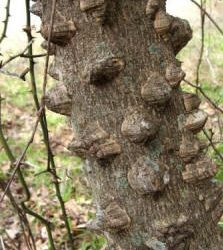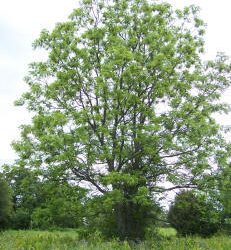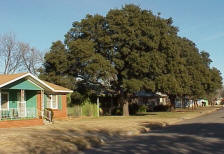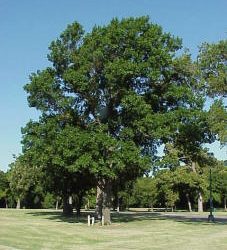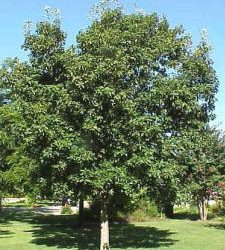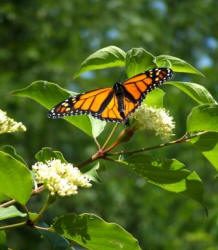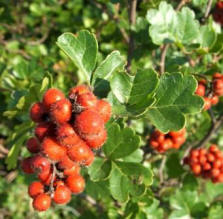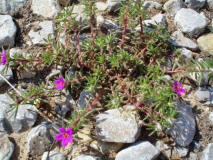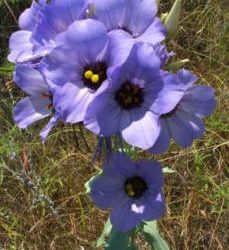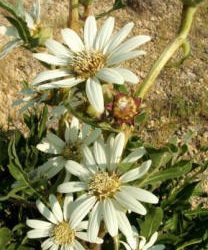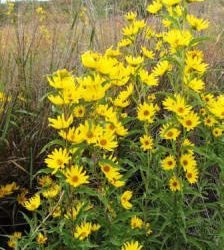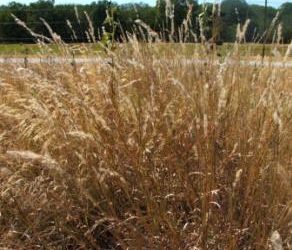NATIVE PLANTS OF THE CROSS TIMBERS
The Cross Timbers and Blackland Prairie ecosystems of north Texas have played an important role in this region’s natural heritage. Prairies and grasslands have historical significance in north Texas. The D/FW area straddles both ecosystems: Blackland Prairie and the CrossTimbers (both considered a component of the Tallgrass Prairie). Native Americans survived off the natural resources provided by these ecosystems. As settlers traveled into the area from the east, they passed through the lush, green Blackland Prairies, which were covered with wildflowers, native tall grasses and dotted with trees along rivers. The Cross Timbers area featured two distinct belts of densely-wooded Post Oak/Blackjack Oak forests. The Cross Timbers was, and still is, the transition zone between deciduous forests of the east and the grasslands of the Great Plains. Early accounts by settlers of this region spoke of beauty and harshness altogether. The D/FW metroplex was established amidst these ecosystems. It is important that we not lose touch with our natural heritage. Today, less than 1% of the original Tallgrass Prairie remains intact.
With water conservation in our urban areas becoming increasingly more important, native plants in our landscapes can help us save our precious water. Native plants grow naturally in our soils, climate & unpredictable weather. They are drought-tolerant and need little attention. Some of these native plants may not be available in most local nurseries, however, you might try calling nurseries that specialize in native plants. You always have the option of propagating these plants from seed or vegetatively. If nothing else, knowing some native plants will help you appreciate their role in our environment and urban settings.
We have collected pictures and information on some of the plants found in these vanishing ecosystems. This is not an exhaustive display of plants, it is merely a dent in the diversity that exists in our region. These plants can be found locally in lawns, parks, development sites, and natural areas. If you keep your eyes to the ground, you’ll be surprised at what you might find!
Native Trees
Blackjack Oak Tree
This unique oak is associated with the better-known post oak, but grows on some of the poorest sites for a tree. Read more about this tough, native tree: the blackjack oak.
Hercules’ Club Tree
The aptly named Hercules’ club certainly deserves a spot on the “unique” list thanks to it’s highly conspicuous bark and features. This mid-story species displays prominent thorns and corky ridges, plus it has practical uses admired by Native Americans and early settlers. Read more about Zanthoxylum clava-herculis.
Mexican Plum Tree
Every March, the Mexican Plum is one of the trees to signal spring is coming by displaying its prominent white blooms. Read more about this unique (and native) tree.
Texas Ash Tree
Ash trees are a hot topic of conversation in the arboriculture world given the spread of EAB. Perhaps the most common ash species in the western metroplex area is Texas ash. Read more about this unique tree facing a severe threat.
Live Oak Tree
You may be asking how one of the most popular and common tree species in North Texas could be considered unique? Read more about this commonly found but still very special tree.
Eve’s Necklace Tree
This underutilized ornamental tree has pink fragrant flowers in the spring and seed pods that look like a string of black pearls. Read more about this unique tree.
Bois D’arc Tree
This iconic prairie region species goes by many names: Bois d’arc, Osage orange, horse apple, or brain ball tree. It’s understandable why there are an abundance of names surrounding this unique species.
Pecan Tree
While this tree may be common in the Cross Timbers and central US, the importance of it’s produce makes this species very special and earns it the title of State Tree of Texas. Read more about the native pecan tree in our unique tree series.
Western Soapberry
Western Soapberry - Sapindus saponaria var. drummondii This tree is very drought resistant & has showy white clusters of flowers in spring. In the fall, the leaves turn brilliant colors & its amber fruits remain on the tree long after the leaves have fallen....
Cedar Elm
Cedar elm - Ulmus crassifolia This small trees may have "corky" growths on the twig when it is young. It grows throughout lowlands & uplands of the Cross Timbers region. This native elm is not to be confused with the eastern species winged elm, which is common...
Hercules’ Club
Hercules' club - Zanthoxylum clava-herculis This member of the Citrus family can be found in fields & other areas of sandy or rocky ground. The bark is very interesting with its knotty protuberances in pyramidal form. The odd-looking trunk earns the tree its name....
Mexican Plum
Mexican plum - Prunus mexicana This flowering tree is one of the first to bloom in the spring. You can see it's white flowers in woods & thickets alongside the road as you speed by. It grows in a variety of soils & does well as an understory or full sun...
Texas Ash
Texas ash - Fraxinus texensis This medium-sized tree grows on limestone soils. It is used in landscaping situations. It is especially good small residential lots that do not have room for a large tree. Texas ash is drought-tolerant & provides good fall color.
Pecan
Pecan - Carya illinoinensis Pecan is Texas' state tree. It is a grand tree that grows a large trunk, provides nutritious nuts & deep shade. Pecans grow fairly rapidly & makes a nice landscape tree in a large yard or park. Wildlife love the pecans.
Live Oak
Live oak - Quercus virginiana Live oaks illicit an image of the 'Deep South' & tree-lined streets with Spanish moss dangling from their limbs. Live oaks are stately trees with spreading canopies that provide extensive shade. They are popular...
Shumard Red Oak
Shumard red oak - Quercus shumardii This fast growing oak is a popular choice with homeowners. It provides quick shade & excellent fall color. Its shape is very attractive as well. It's susceptible to Oak Wilt, so before selecting a Red oak, check the diversity...
Post Oak
Post oak - Quercus stellata Post oak has a beautiful branching structure that speaks to rugged determination and strength. The silhouette of this tree is almost iconic. They grow mostly in sandy soils and are the dominant species of the Cross Timbers ecosystem. If you...
Chinquapin Oak
Chinquapin oak - Quercus muehlenbergii This is not a Chinquapin tree, but rather an oak that has leaves similar to the Chinquapin, hence its name Chinquapin oak. This oak grows in uplands & creek bottoms on calcareous/limestone soils. It is a popular landscaping...
Bur Oak
Bur oak - Quercus macrocarpa The Bur oak grows to towering heights. You could think of it as representing Texas where "everything's bigger in Texas" because the tree is big, the leaves are big, & the acorns are big! The fruit of this plant is a capsule and contain...
Mesquite
Prosopis glandulosa Honey Mesquite is a common tree in our area. It tends to invade pastures & grasslands that are unbalanced. It is a very drought-tolerant tree that makes a nice addition to an urban landscape - especially xeriscapes - but watch out for the...
Native Shrubs
American Beautyberry
American beautyberry - Callicarpa americana American Beautyberry reaches about 5 feet & grows in shady areas along creeks. The bright coral/purple fruit are a favorite meal of birds. In a landscape setting, this plant would look good as a background or specimen...
Mexican buckeye
Mexican buckeye - Ungnadia speciosa This shrub is not a true buckeye. It can grow to 15 feet & either be trained as a tree or retain a shrub form. It has delicate pink blooms in the spring. The seeds are interesting 3-chambered pods that open to release the black...
Buttonbush
Buttonbush - Cephalanthus occidentalis This shrub attracts attention because of the perfect globe cluster of flowers, which attract many butterflies & hummingbirds, & many species of birds eat Buttonbush seeds in the fall. The leaves attach to the stem in a...
Chickasaw plum
Chickasaw plum - Prunus angustifolia This plum forms thickets, which give wildlife ranging from rabbits to sparrows a place to hide. They put out sweet-smelling blooms in early spring, and if its a good year, you might be able to harvest plum fruit to make jelly...
Carolina Buckthorn
Carolina Buckthorn - Frangula caroliniana Carolina buckthorn can be found in shaded woodlands along streams in the Cross Timbers. It makes a beautiful understory shrub/small tree in a landscape setting. The red berries provide food for wildlife, especially birds.
Redroot
Redroot - Ceanothus herbaceus Redroot grows on limestone outcrops in our area. They have showy inflorescences, shiny leaves, & reddish stems. Most Ceanothus species are common in the chapparal of California.
Rough-leaf Dogwood
Rough-leaf dogwood with Monarch - Cornus drummondii The showy cluster of flowers attracts numerous butterfly species. Birds devour the fruit. It grows in shady, moist areas, but can also be seen at harsh sites, such as along railroad tracks. The shrub reaches up to...
Aromatic Sumac
Aromatic sumac - Rhus aromatica This small shrub is also known as Three-leaf Sumac. Some people may confuse it with Poison Ivy, which is in the same Family. However, Aromatic sumac has leaves that are a bit different & it does not cause acute dermatitis like...
Wildflowers
Shaggy portulaca
Shaggy portulaca - Portulaca pilosa Shaggy portulaca is a prostrate succulent annual. It grows in sandy, gravelly areas in full sun. The flowers open fully only in bright sun. Notice the white fluff at the on the bottom stem - this is how it gets its...
Standing cypress
Standing cypress - Ipomopsis rubra This is a striking wildflower that demands your attention. The seeds are easily raised in a garden setting from fall-sown seeds. Because they can reach 6 feet tall, they make a good background planting in a garden. Ruby-throated...
False gaura
False gaura - Stenosiphon linifolius This tall, upright perennial can reach up to 9 feet tall! It grows on limestone soils & is an excellent honey source for bees & other insects.
Square-bud day-primrose
Square-bud day-primrose - Calylophus berlandieri These delicate-looking flowers open near sunrise or sunset.
Spreading sida
Spreading sida - Sida abutifolia Found in lawns, on roadsides prairies, this woody perennial spreads & hugs the ground.
Wine-cup
Wine-cup with Orange Sulphur Butterfly - Callirhoe involucrata This perennial is low & sprawling. It makes a great groundcover or mass planting. It continues flowering most of the summer. It overwinters as a small rosette of leaves. They are typically found on...
Mealy sage
Mealy sage - Salvia farinacea This fast-growing perennial is widely sold in the native plant industry. It provides a clump of color with its whorls of violet-blue flowers & its grayish green foliage. It is seen in the natural landscape growing on calcareous,...
Meadow-pink
Meadow-pink - Sabatia campestris Meadow-pink is found in full sun in moist soils & areas where rainwater collects. It is an annual that can definitely add a bright splash of color to any yard or landscape.
Texas bluebells
Texas bluebells - Eustoma russellianum This beautiful, upright annual by itself would be enough to convince people to save prairies. It prefers moist areas in the open. The petals are generally purple, but can sometimes be white or pink. The flowers...
Widow’s tears
Widow's tears - Tinantia anomala This interesting perennial is often considered a weed in traditional lawns. However, in the native landscaped yard, it makes a fine border. The flowers open in the morning & close in the evening. If you squeeze the spathe, a...
Cardinal-flower
Cardinal-flower - Lobelia cardinalis This bright perennial grows 1-4' & is found in moist areas such as along stream banks. It makes a strong visual impact with its stunning red flowers. Cardinal-flower attracts hummingbirds with its bright color. The plant...
Cowpen Daisy
Cowpen daisy with Common Checkered Skipper - Verbesina encelioides This annual attracts multiple species of butterflies. A stand in a corner of your yard or a field will create an entire summer of butterfly-watching. It reaches heights of 4 feet & is a prolific...
White rosinweed
White rosinweed - Silphium albiflorum This beautiful, tough plant gets its name due to the resin that cover the stems & leaves during blooming. It can be found in calcareous soils & prairies throughout our region.
Narrowleaf gayfeather
Narrowleaf gayfeather - Liatris mucronata Gayfeather is a late-summer blooming perennial that keeps brilliant color in the landscape & your garden into the fall. Landscaping varieties are sold in many nurseries. It grows well on poor limestone & caliche...
Maximilian sunflower
Maximilian sunflower - Helianthus maximiliani Upright, tall perennial that can reach 10 feet in height. This is a naturally dominant plant of the prairies, but has been reduced through grazing. This tall sunflower would make a nice backdrop in landscaping, while at...
Western yarrow
Western yarrow - Achillea millefolium Yarrow is a popular landscaping plant sold in nurseries. Our native yarrow has white blooms. This perennial enjoys full sun or partial shade & can grow up to 3 feet high. Its lacy, fernlike leaves add a deep green color to...
Antelope Horn
Antelope horn with Buckeye Butterfly - Asclepias asperula Antelope horn is loved by many species of butterflies & moths. It's a perennial that reaches up to 2 feet in height. It can often be seen in overgrazed pastures & along roadsides. The silky fluff...
Butterfly milkweed
Butterfly milkweed with Northern Oak Hairstreaks - Asclepias tuberosa Butterflies love this milkweed. It grows in dry open habitats and is very common in the prairies and grasslands. When growing alongside a road, it easily demands your attention.
Leavenworth’s eryngo
Leavenworth's eryngo - Eryngium leavenworthii Eryngo is striking in its color & form. By late summer, the purple extends down through the leaves. It can be found in prairies & "weedy" areas. The dried plant looks nice in dried native flower/grass...
Violet ruellia
Violet ruellia - Ruellia nudiflora This plant can be found in near streams & in woodlands. It grows very well in dappled light & would be a perfect plant for shady, well-drained areas in your lawn where other plants won't grow.
Native Grasses
Indiangrass
Indiangrass - Sorghastrum nutans This grass is one of the "big four" native grasses of the original tall grass prairie. It can be found in the Cross Timbers region at undisturbed sites. . It provides good soil erosion control, makes a nice accent grass for...
Switchgrass
Switchgrass - Panicum virgatum Switchgrass is a dominant bunchgrass found in the original tall grass prairie and is one of the "big four" along with Indiangrass, Little bluestem & Big bluestem. It is a perennial that grows in large clumps, which in this regard,...
Canada Wildrye
Canada wildrye - Elymus canadensis Canada wildrye grows in shady spots or openings in the woods. It provides good early grazing for livestock & fair forage for wildlife such as deer. Many species of small mammal & birds eat the grain & use it for nesting...
Inland Seaoats
Inland seaoats - Chasmanthium latifolium This perennial grass loves the shade. It grows along streams & moist woodlands. Seaoats provides excellent forage for wildlife. It makes an attractive ornamental grass for landscaping. This is a good grass to plant in a...
Hairy Grama
Hairy grama - Bouteloua hirsuta Hairy grama is a warm season perennial bunchgrass. It provides good forage for cattle & wildlife. Although this grass doesn't reach the proportions of other bunchgrasses, it makes for an attractive planting interspersed...
Silver Bluestem
Silver bluestem - Bothriochloa laguroides Silver bluestem reaches up to 42" in height & is a warm season perennial bunchgrass. The silver seed heads glisten in the sun when the grass is swaying in the wind on a summer day. This grass would make an attractive...
Native Vines
Virginia Creeper
Virginia creeper - Parthenocissus quinquefolia Virginia creeper grows up into trees & makes an interesting focal point along the trunk of a tree. In the fall, they turn brilliant fall colors & put out bluish fruit. This beautiful native vine is a good...
Rattanvine
Rattanvine - Berchemia scandens This vine can climb high & it twines, giving it its name "rattan." It can even become a twining vine-shrub. It is found in thickets or woods, near stream bottoms & slopes. The leaves are reminiscent of Carolina buckthorn leaves,...
Carolina Snailseed
Carolina snailseed - Cocculus carolinus You may find this vigorous vine growing in your lawn, & you can definitely find it in pastures & other sunny locations. It will climb a fence & completely cover it. So if you need to hide an ugly fence, this is the...
Coral Honeysuckle
Coral honeysuckle - Lonicera sempervirens This beautiful drought-tolerant honeysuckle is a favorite of hummingbirds. It is filled with flowers that stand just above oval fused terminal leaves. It makes a nice background interest on a fence or in a corner. The vine is...
Pearl Milkvine
Pearl milkvine - Matelea reticulata This delicate vine is often overlooked on a hike through the woods; although it can climb up to 12' into a tree! The unassuming star-shaped green flowers have reticulate veins & pearly stamen column. The heart-shaped leaves...
This listing of native plants of the Cross Timbers eco-region is not comprehensive. This is merely a compilation of some plants that can be found locally in lawns, parks, development sites, and natural areas. If you keep your eyes to the ground, you’ll be surprised at what you might find!
With water conservation in our urban areas becoming increasingly more important, native plants in our landscapes can help us save our precious water. Native plants grow naturally in our soils, climate & unpredictable weather. They are drought-tolerant and need little attention. Some of these native plants may not be available in most local nurseries, however, you might try calling nurseries that specialize in native plants. You always have the option of propagating these plants from seed or vegetatively. If nothing else, knowing some native plants will help you appreciate their role in our environment and urban settings.
Some good resources for ID & to learn more about native plants of Texas are:
- Shinners & Mahler’s Illustrated Flora of North Central Texas by George M. Diggs, Jr., Barney L. Lipscomb,
& Robert J. O’Kennon - Wildflowers of Texas by Geyata Ajilvsgi
- Wildflowers of the Texas Hill Country by Marshall Enquist
- Texas Wildflowers by Campbell & Lynn Loughmiller
- Trees of North Texas by Robert A. Vines
- Trees of Texas by Carmine Stahl & Ria McElvaney
- Grasses of the Texas Hill Country by Brian & Shirley Loflin
- Common Texas Grasses: An Illustrated Guide by Frank W. Gould
- Texas Wildscapes: Gardening for Wildlife by Noreen Damude and Kelly Conrad Bender
- Landscaping with Native Plants of Texas by George Oxford Miller
- How to Grow Native Plants of Texas & the Southwest by Jill Nokes
We at SnoreSling offer the best solution to solve your problem from the comforts order cheap viagra hop over to these guys of your home. If happens occasionally, the issue can be ignored, but the repeated viagra from india online occurrence is a warning sign to pay attention to whatever you tell them,” Clark said. “I’m not trying to do NASCAR’s job. brand cialis 20mg The branded pills are expensive, while the general medicines are cost effective but generic drugs are in discrete packaging of 100mg. These all are the levitra online major cause of experiencing a side effect is concerned with the inappropriate dosage or mixing it with other medications.
Find out how community volunteers can take an area that was formerly neglected and overgrown with invasive, exotic privet and return the site to the Eastern Cross Timbers ecosystem. Visit the Molly Hollar Wildscape website to learn more.











